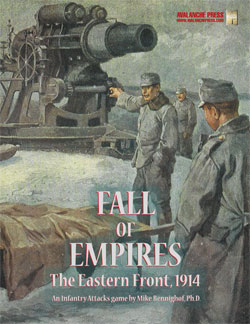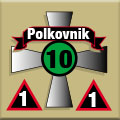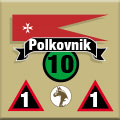| August 1914, Fall of Empires:
The Tsarist Army of 1914
By Robert D. Williams
December 2024
 Tactics Tactics
In 1914 the Russian Army was still absorbing the lessons of the Russo-Japanese War of 1904–1905, so many of the faults discovered in that conflict had not yet been corrected. In addition, despite the tremendous increase in firepower over the course of the nineteenth century, Russian tactical doctrine still relied too heavily on shock instead of fire combat, still adhering to the maxim of Catherine the Great’s General Suvorov that “the bullet’s a fool, but the bayonet’s a fine fellow.”
Infantry
An infantry company could be drawn up in close order, open order, or extended order, but no fixed interval was prescribed for open and extended order, other than that the men should be at least one pace (28–35 inches) apart. In combat the company was usually formed with the men at intervals of two to four yards, the 1st and 2d platoons in line forming the first line, the 3d and 4th the second line, with intervals and distances of about 30–40 yards between platoons. However, the company commander might designate one or more platoons as a reserve and form the remainder of the troops in a different manner. Depending on its formation, the usual frontage of a company in combat was between 200 and 300 yards.
A battalion would be formed up with one to four companies forward and the remainder in reserve; thus a battalion’s frontage would vary between 200 and 1,200 yards, depending on the number of companies in line.
 At about 2,500 to 3,000 yards from the enemy, the companies would deploy into their attack formations and would open fire at about 800 yards. One company or battalion, designated as the “rifle battery” (ruzheynaya batareya) would occupy a position on the flank and slightly in front to lay down a heavy fire until masked. Volleys were still used down to 1,400 yards and occasionally at closer ranges. At 40–50 yards the bayonet attack was launched, with the men shouting “hurrah!” (“urá!”) and firing on the run. At about 2,500 to 3,000 yards from the enemy, the companies would deploy into their attack formations and would open fire at about 800 yards. One company or battalion, designated as the “rifle battery” (ruzheynaya batareya) would occupy a position on the flank and slightly in front to lay down a heavy fire until masked. Volleys were still used down to 1,400 yards and occasionally at closer ranges. At 40–50 yards the bayonet attack was launched, with the men shouting “hurrah!” (“urá!”) and firing on the run.
On the defensive, Russian troops were trained to counter-attack when the enemy had approached to within 50 yards of their position.
Machine guns were always deployed in two-gun sections, with one section being allotted to each battalion in the regiment. In the attack they were supposed to be pushed well forward.
Cavalry
 A cavalry squadron generally formed for combat with two to three troops forward in line and one or more in reserve. To attack enemy horse, the cavalry would start at the trot in extended order. At 400 yards they would go to the gallop, at 100 yards to the charge and close ranks. When attacking infantry, the first echelons would be in a single rank in extended order, the rear echelons in one or two ranks in open order. If attacking artillery, they formed in two extended lines about 300 yards apart, with the first line in a single rank, the second in two. A cavalry squadron generally formed for combat with two to three troops forward in line and one or more in reserve. To attack enemy horse, the cavalry would start at the trot in extended order. At 400 yards they would go to the gallop, at 100 yards to the charge and close ranks. When attacking infantry, the first echelons would be in a single rank in extended order, the rear echelons in one or two ranks in open order. If attacking artillery, they formed in two extended lines about 300 yards apart, with the first line in a single rank, the second in two.
Cavalry could also employ the lava, an offensive tactic formerly used only by the cossacks. This was usually conducted by individual squadrons formed with two to three troops in widely extended order, often in a crescent formation, with the reserve squadron about 75–200 yards to the rear, and was intended as a harassing tactic to disrupt the enemy prior to an attack, to screen a maneuver, or delay his advance. Part of the lava could be dismounted to conduct fire.
Russian cavalry doctrine since the 1870’s had encouraged dismounted combat under certain circumstances. Cavalry could dismount “normally” or “reinforced.” In the first, two-thirds of the men would dismount, with the remainder acting as horse-holders; in the second, only one man in six remained mounted. Cossack cavalry could dismount all but one man per troop. Dismounted fire was conducted by individual troops occupying a frontage of 35 to 70 yards. Individual aimed fire at close range was the normal tactic, but volley fire could also be employed, and on the defensive, long-range fire could be used to force an enemy to deploy sooner.
Artillery
 Each artillery battery was provided with 11 mounted and 18 dismounted scouts, observers, and signalers. These were formed into advance parties of 6–8 men who moved with the advance guard in order to locate and occupy good observation positions. Artillery commanders received precise instructions concerning mission, location, when firing is to commence, further locations to be occupied if required, etc. Guns would also be detailed to accompany the advancing infantry to engage enemy artillery and machine guns and destroy any obstacles blocking the advance. Artillery observers accompanied the infantry to report when the infantry were about to be endangered by friendly artillery fire, and the infantry was supposed to signal their position with flags or some other method. Each artillery battery was provided with 11 mounted and 18 dismounted scouts, observers, and signalers. These were formed into advance parties of 6–8 men who moved with the advance guard in order to locate and occupy good observation positions. Artillery commanders received precise instructions concerning mission, location, when firing is to commence, further locations to be occupied if required, etc. Guns would also be detailed to accompany the advancing infantry to engage enemy artillery and machine guns and destroy any obstacles blocking the advance. Artillery observers accompanied the infantry to report when the infantry were about to be endangered by friendly artillery fire, and the infantry was supposed to signal their position with flags or some other method.
Ranks
 Peter the Great, as part of his program of modernizing and westernizing Russia, endeavored to curb the power of the old, anti-western nobility, or boyars, by changing all military and civil posts from hereditary offices to appointments based on merit, allowing even commoners to advance to high office. The new system was formalized in the Table of Ranks (Tabel’ o rangakh), created in 1722. This system, modified several times in the two centuries between the reigns of Peter I and Nicholas II, remained until the fall of the monarchy the basis of all rank, both civil and military, in the Russian Empire. In the same manner that the modern US military has a unified system of ranks across all four services, so the Russians had a unified system of ranks not only for the Army, the Navy, and the Imperial Guard, but also for the Civil Service and Court offices, so that, for example, a nadvorny sovetnik (court counsellor) at Class 7 was equal in rank to a captain or rotmistr in the Imperial Guard, a lieutenant colonel or voyskovoy starshina in the line, or a captain second rank in the Navy. Peter the Great, as part of his program of modernizing and westernizing Russia, endeavored to curb the power of the old, anti-western nobility, or boyars, by changing all military and civil posts from hereditary offices to appointments based on merit, allowing even commoners to advance to high office. The new system was formalized in the Table of Ranks (Tabel’ o rangakh), created in 1722. This system, modified several times in the two centuries between the reigns of Peter I and Nicholas II, remained until the fall of the monarchy the basis of all rank, both civil and military, in the Russian Empire. In the same manner that the modern US military has a unified system of ranks across all four services, so the Russians had a unified system of ranks not only for the Army, the Navy, and the Imperial Guard, but also for the Civil Service and Court offices, so that, for example, a nadvorny sovetnik (court counsellor) at Class 7 was equal in rank to a captain or rotmistr in the Imperial Guard, a lieutenant colonel or voyskovoy starshina in the line, or a captain second rank in the Navy.
Officer ranks in 1914 were roughly equivalent to those in the current US military, but there were far fewer enlisted ranks. As can be seen from the example given above, the same rank differed in name not only between the services, but often also between the combat branches of the Army. A private was a ryadovoy in the infantry and cavalry, a kanonir in the artillery, and a kazak in the cossacks. A corporal was a yefreitor in the infantry and cavalry, a bombardir in the artillery, and a prikazny in the cossacks. The next rank, junior sergeant, wasmladshi unter-ofitser in the infantry and cavalry, mladshi feyerverker in the artillery, and mladshi uryadnik in the cossacks. The rank of senior sergeant varied the same way: starshi unter-ofitser, starshi feyerverker, andstarshi uryadnik. The next rank was that of first sergeant: fel’dfebel’ in the infantry and artillery, vakhmistr in the cavalry, horse artillery, and cossacks. Above first sergeant was the rank of podpraporshchik (infantry, cavalry, and artillery) or podkhorunzhi (cossacks). This may be considered as roughly equivalent to a warrant officer in the modern US Army—though the Russian podpraporshchik was closer to being an NCO than is the American warrant officer.
Thus, there were six enlisted ranks: private, corporal, junior sergeant, senior sergeant, first sergeant, and warrant officer.
 The lowest officer rank was that of ensign (praporshchik), which existed only in the line infantry and only during wartime. Otherwise, the most junior commissioned rank (Class 12) was that of second lieutenant: podporuchikin the infantry and artillery, kornet in the cavalry, khorunzhi in the cossacks. A first lieutenant (Class 10) was aporuchik in the infantry, artillery, and cavalry, and a sotnik in the cossacks. Class 9 was the rank of staff-captain (shtabs-kapitan in the infantry and artillery, shtabs-rotmistr in the cavalry, podyesaul in the cossacks); a captain (kapitan, rotmistr, yesaul), Class 8, was generally the officer in command of a company, squadron, or artillery section. Class 7 was lieutenant colonel (podpolkovnik in the infantry, artillery, and cavalry, voyskovoy starshina in the cossacks); Class 6 colonel (polkovnik in all branches). The lowest officer rank was that of ensign (praporshchik), which existed only in the line infantry and only during wartime. Otherwise, the most junior commissioned rank (Class 12) was that of second lieutenant: podporuchikin the infantry and artillery, kornet in the cavalry, khorunzhi in the cossacks. A first lieutenant (Class 10) was aporuchik in the infantry, artillery, and cavalry, and a sotnik in the cossacks. Class 9 was the rank of staff-captain (shtabs-kapitan in the infantry and artillery, shtabs-rotmistr in the cavalry, podyesaul in the cossacks); a captain (kapitan, rotmistr, yesaul), Class 8, was generally the officer in command of a company, squadron, or artillery section. Class 7 was lieutenant colonel (podpolkovnik in the infantry, artillery, and cavalry, voyskovoy starshina in the cossacks); Class 6 colonel (polkovnik in all branches).
There were four ranks of general officers: major general (general-mayor), lieutenant general (general-leytenantor general-poruchik in the artillery and engineers), full general (polny general), and field marshal (general-fel’dmarshal). Full generals were further distinguished (as in the German Army) by their branch of service:general ot infanterii, general ot artillerii, general ot kavalerii, general-inzhener.
Ranks in the Imperial Guard were considered to be one level higher than their line equivalents. Thus, a shtabs-kapitan of the Guard was ranked as Class 8 rather than Class 9, and the rank of lieutenant colonel did not exist in the Guard, officers being promoted directly from captain to colonel.
Conclusion
 The Russian Army in 1914 did not greatly differ in its organization and doctrine from the other major European armies of the time. Ranks, despite some uniquely Russian nomenclature, were generally the same as those found in other armies of the time period. The Russians had “fronts” above the army level, a term not used in the same fashion in the West, and usually called battalions “diviziony,” but otherwise used the same organization as other armies: platoons, companies, battalions, regiments, brigades, divisions, corps, and armies. Infantry doctrine placed too much emphasis on the bayonet attack (though, in fact, this was no more mistaken a doctrine than the French belief in the supremacy of the attack), but cavalry tactics relied more heavily on dismounted combat than those of any other European power—a lesson the Russians alone among the European powers had learned from the American Civil War. The Russians’ greatest weakness—aside from the often astounding incompetence of their senior commanders—was their artillery, which was less numerous and less powerful than that of their enemies—a debility the Russians would find it almost impossible to rectify, due to their inadequate industrial production and the general incompetence of the government bodies controling industrial output. In common with the other belligerents of 1914, the Russians expected a short, victorious war and had not planned adequately for the mobilization of human replacements, the production of material replacements, or the enormous ammunition consumption that would ensue in 1915. Unlike the others, however, Russia had neither the industrial capacity to produce the materiel or the state mechanisms to channel that production efficiently. The result, in combination with the incompetence of many of the senior Russian commanders, would be dire shortages in arms, ammunition, and supplies throughout the war, and the eventual collapse of the war effort in 1917. The Russian Army in 1914 did not greatly differ in its organization and doctrine from the other major European armies of the time. Ranks, despite some uniquely Russian nomenclature, were generally the same as those found in other armies of the time period. The Russians had “fronts” above the army level, a term not used in the same fashion in the West, and usually called battalions “diviziony,” but otherwise used the same organization as other armies: platoons, companies, battalions, regiments, brigades, divisions, corps, and armies. Infantry doctrine placed too much emphasis on the bayonet attack (though, in fact, this was no more mistaken a doctrine than the French belief in the supremacy of the attack), but cavalry tactics relied more heavily on dismounted combat than those of any other European power—a lesson the Russians alone among the European powers had learned from the American Civil War. The Russians’ greatest weakness—aside from the often astounding incompetence of their senior commanders—was their artillery, which was less numerous and less powerful than that of their enemies—a debility the Russians would find it almost impossible to rectify, due to their inadequate industrial production and the general incompetence of the government bodies controling industrial output. In common with the other belligerents of 1914, the Russians expected a short, victorious war and had not planned adequately for the mobilization of human replacements, the production of material replacements, or the enormous ammunition consumption that would ensue in 1915. Unlike the others, however, Russia had neither the industrial capacity to produce the materiel or the state mechanisms to channel that production efficiently. The result, in combination with the incompetence of many of the senior Russian commanders, would be dire shortages in arms, ammunition, and supplies throughout the war, and the eventual collapse of the war effort in 1917.
Bibliography
This article has been based principally upon two works:
Markov, O. D., Russkaya Armiya, 1914–1917 gg., Izdatel’stvo “Galeya Print”, St. Petersburg, 2001.
General Staff, War Office, Handbook of the Russian Army. Sixth Edition. 1914, The Imperial War Museum, Department of Printed Books in association with the Battery Press, Nashville, and Articles of War, Skokie, 1996.
Also consulted was: http://www.akunin.ru/istoria/tabel/
You can order August 1914 right here.
You can order Fall of Empires right here.
Infantry Attacks Package
August 1914
Fall of Empires
Franz Josef’s Armies
Winter’s Battle
Black Mountain
Retail Price: $266.95
Package Price: $215
Gold Club Price: $172
Experience the Infantry Attacks Package right here.
Sign up for our newsletter right here. Your info will never be sold or transferred; we'll just use it to update you on new games and new offers.
|
